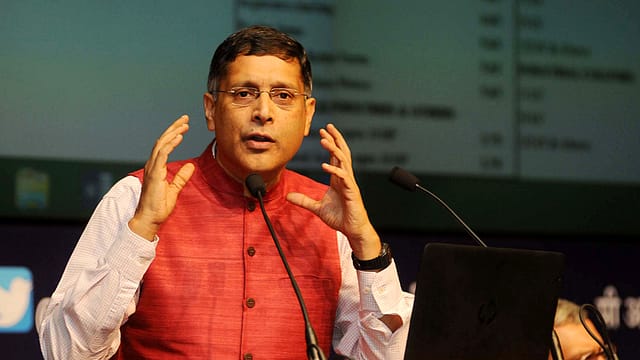The importance of being Arvind Subramanian
ADVERTISEMENT

How can you turn the government’s dull, number-heavy annual economic report card which provides policy prescriptions into an interesting read packed with new insights and novel ideas?
For a ready answer, turn to the writings of Arvind Subramanian, the well-known economist and an alumnus of St Stephen’s College, Indian Institute of Management Ahmedabad and Oxford University, who announced his resignation from the post of the government’s chief economic advisor on Wednesday. Or read the Economic Surveys that he produced with such meticulous care in his four-year fruitful tenure, which was also a time that saw some major structural changes in the economy such as the demonetisation, the introduction of the goods and services tax, and the Insolvency and Bankruptcy Code 2016.
These documents have not only became a must-read document for policymakers, economists and other intellectuals to draw an insight into the government’s economic thinking, but also for the common man interested in the country’s economy and his own well-being. They have become compulsory reading for university students too. It’s a compelling read with catchy headlines and a quick turn of phrase, while maintaining the gravity of the subject, or its importance in the prevalent conditions. It has helped many people understand the complexity of government policy making and its implementation and also how to write on serious economic topics with a light touch.
Take for instance a chapter from his Economic Survey 2015-16 entitled “The Chakravyuha Challenge of the Indian Economy: From socialism with restricted entry to ‘marketism’ without exit”, a chapter that so succinctly encapsulated the dilemma of promoters burdened with bankrupt or near-bankrupt companies. Such incisive analysis could well be described as the forerunner of the Insolvency and Bankruptcy Code 2016, enacted by the Narendra Modi government. Or the chapter, “Bounties for the Well-Off”, which highlight that existing policies based on providing tax incentives will, in India, end up benefitting not the middle class but those at the very top end of the income distribution, and hence calls for a re-look.
January 2026
Netflix, which has been in India for a decade, has successfully struck a balance between high-class premium content and pricing that attracts a range of customers. Find out how the U.S. streaming giant evolved in India, plus an exclusive interview with CEO Ted Sarandos. Also read about the Best Investments for 2026, and how rising growth and easing inflation will come in handy for finance minister Nirmala Sitharaman as she prepares Budget 2026.
Chapters that immediately catch the readers’ attention in the Economic Survey 2017-18 include those that discuss the twin balance sheet problem in India: the balance sheet of companies which is overleveraged, and that of banks bogged down by non-performing assets; the challenges faced by the government in using the Jan Dhan-Aadhar-Mobile (JAM) strategy to prevent leakage of subsidies; or the need for a universal basic income scheme; and the concept of a bad bank, which will buy out the toxic assets from loss-making banks and provide them with a relatively clean balance sheet. There was also an interesting chapter on the importance of migration and internal trade.
While many of his policy prescriptions may not have found favour with the political bosses, he points out in an article he wrote that the Survey’s aim is always to build a portfolio of contributions, combining description, new data creation, deep-dive research, and provocative policy ideation. And he has actually lived up to his promise, despite some frustrations.
Then there are his books written singly or in collaboration with others. These include authoritative accounts on the country’s economy such as India’s Turn: Understanding the Economic Transformation; Eclipse: Living in the shadow of China’s Economic dominance; and Who Needs to Open the Capital Account, with John Williamson and Olivier Jeanne among others, not to mention hundreds of articles written in various newspapers, including a regular column in Business Standard.
Subramanian can make powerful statements with subtlety. There was considerable talk about the pink cover of the Economic Survey 2017-18. He would later remark that this was his way of showing support for the growing movement to end violence against women. Chapter 7 of the Economic Survey 2017-18 underlines his belief that the deep societal meta-preference in favour of sons could only be addressed by empowering women with education.
Among the positive changes brought about by Subramanian was the course on Indian economy on the massive open online course portal on the website of the Ministry of Human Resources Development. The Economic Survey 2017-18 has five chapters that discuss in detail the long-term challenges facing the Indian economy: gender inequality, climate change and agriculture, delays in the appeals, judicial process, and science and technology. But Subramanian and his team went the extra mile to educate students on these issues. And he hopes that the new tradition continues after his exit.
In fact, it was the Prime Minister Narendra Modi picked Subramanian for the CEA’s post in 2014, which was left vacant by former International Monetary Fund (IMF) chief economist Raghuram Rajan when he took over the reins of India’s central bank. Subramanian’s return to the academic environment of the US and his family may be great news for him, but his legions of fans in India will miss him.
